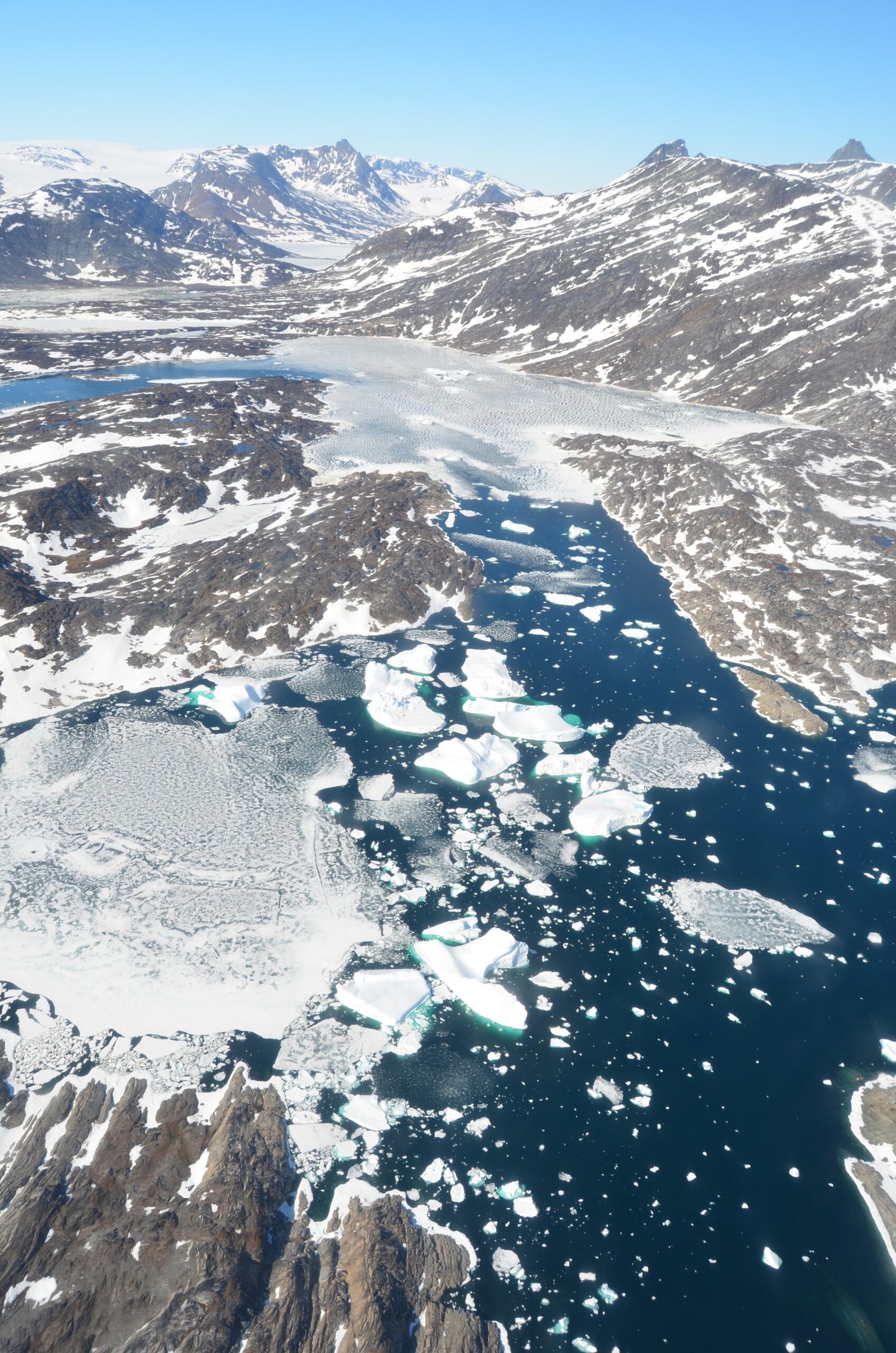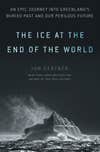Saving Greenland could save the world
Excerpt: Ice at the End of the World

Every year, about half of Greenland’s ice losses happen on the edges, through glaciers like Jakobshavn. But another half is lost through melting on its surface. This melting comprises turquoise lakes and rushing aquamarine rivers and thin lapis creeks. Unlike the island’s biggest glaciers, we already know a fair amount about how much the ice sheet’s surface is warming. For nearly thirty years, a Swiss scientist named Konrad “Koni” Steffen has been taking readings on temperature, wind, solar radiation, and melting at a station known as Swiss Camp, on the central ice sheet. Located about fifty miles east of Jakobshavn’s calving front, Steffen’s camp has weather towers that collect data on the surface environment several times a minute; the information is then transmitted to him in Europe and the United States (he has offices in both Zurich and Boulder) every hour. But the observations aren’t limited to one location. over the past few decades, he has set up a system of eighteen installations around Greenland that measure weather on the ice sheet. Every spring he checks on these towers by setting out from Swiss Camp, moving from one site to another either by snowmobile or by turboprop. “It is really by chance that I ended up studying the ice sheet,” he says.
The station over time had become a destination spot for visit- ing dignitaries seeking to find a kind of ground zero for global warming; Al Gore had been there, along with so many journalists, politicians, and European princesses and princes that Steffen could barely list them all. The true value of Swiss Camp was in the growing record of observations, however. Steffen calculated that between 1990 and 2018 average temperatures on the ice sheet had increased by about 2.8 degrees Celsius, or 5 degrees Fahrenheit. Over the same time period, the total area of the Greenland ice sheet that was vulnerable to surface melting had increased by around 65 percent. Carl Benson would barely have recognized the place.
In talking about the melting in Greenland, glaciologists sometimes like to describe the relationship between rising temperatures and diminishing ice with mock simplicity: “When it gets hotter,” they say, “ice melts.” And yet the surface of the ice sheet has turned out to be far more complex than it once appeared. In recent years, studies have observed that meltwater from the ice sheet doesn’t necessarily run off Greenland into the oceans; occasionally it stays in the firn, trapped like water in a huge sponge. In 2013, a team of scientists even discovered an aquifer under the snow in east Greenland, containing extraordinary reserves of water that covered an area the size of West Virginia. Conceivably, the water could be released quickly, in a flooding gush, in the near future.

In sum, the ice surface is beset by a variety of forces brought on by changing climates. The surface is getting darker, for instance, thanks to a combination of industrial soot, dust, microorganisms, and algae, which have settled upon a “dark zone” on the ice sheet’s western region. This dust, black carbon, and biological life now form an ecosystem that flourishes during the warmer months. But the danger is that the darker Greenland’s ice gets, the more solar energy it absorbs. And the more solar energy it absorbs, the more it melts and the darker it gets. This feedback loop is known by glaciologists as the albedo-melt loop (albedo is a measure of surface reflectivity). And unfortunately, it is reinforced by another self-perpetuating process. As Greenland’s ice sheet melts and drops in elevation, just as it has at Koni Steffen’s Swiss Camp, its ice becomes more vulnerable. Lower altitudes enjoy warmer temperatures; they allow lakes to creep farther up the ice sheet with each passing decade. Therefore it now appears that the more Greenland melts, the more Greenland melts.
At its current pace of erosion, Greenland’s ice sheet adds about one millimeter of water every year to the world’s oceans; at this rate, the ice sheet could last seven thousand years. Yet no glaciologist in the world seems to think this will be the case. An astonishing study published in December 2018 concluded that the ice sheet was now melting faster than at any time for at least the past 350 years, and that the “nonlinear” response of the ice to warmer temperatures would lead to “rapid in- creases” in Greenland’s sea-level contributions. With its mellifluous, singsong Swiss accent, Koni Steffen’s voice tends to soften the bleakness of his outlook. Yet in his reflective moments, he predicts the melting ice over time will lead to a painful migration of 300 to 500 million people, globally, away from the coast. “Greenland isn’t pausing at 2100,” he says. “It continues like this, the warming. And it gets worse and worse. Most people think we can model until 2100, and that 2 degrees centi- grade is not so bad. But it won’t stop there. And the melting won’t stop there. The curve gets steeper, and steeper, and steeper.” one evening in Greenland, he says darkly: “There will be a change coming, and obviously a change that we have not seen in thousands of years.”
It may be the case that the collapse of some glaciers in West Antarctica and Greenland is unstoppable. But for the moment there is great uncertainty when it comes to the ice sheets. It may take one hundred years or three hundred years or five hundred years for some glaciers to fall into the ocean, due largely to the way they will break, sliding backward in the process, sometimes pausing for years or decades on a bedrock bump, as sea waters around and underneath them warm. In any event, amongst glaciologists there seems a consensus that the situation is urgent now, even if it isn’t yet at the point of being catastrophic. “We’re not positive if we’ve already triggered it or if we’re really close,” Pennsylvania State University geoscientist Richard Alley says of a West Antarctica collapse. “I think almost everyone would agree that it’s either one or the other.” But Alley also thinks that if we have committed to losing West Antarctica, “Greenland just became way more valuable.”
This can require a bit of explanation. It’s largely due to the fact that Greenland’s ice sheet sits within a bowl and is ringed by mountains, just as German polar researcher Alfred Wegener’s expedition discovered almost a century ago. Even with its deep glaciers, the losses of ice are constrained to a certain degree by the island’s geography, and by the limits in how glaciers can only push ice into the sea by threading through narrow mountain passes. That isn’t to say that Greenland couldn’t contribute many feet of sea level rise over the next few centuries. But with Greenland, says Alley, “we have a little more leeway.”
To meet the Paris Agreement goals, which attempt to limit average global warming to 2 degrees Celsius, “the wealthier parts of the world would need to be zero carbon energy by about 2035,” Kevin Anderson, a climate scientist at the University of Manchester, explains. “And the poorer parts, including China, would have to deliver zero carbon energy by about 2050. And by that I mean everything—cars, planes, ships, industry, all of the energy would be zero carbon by 2050, globally, for us to have a reasonable chance of the two-degree framing of climate change.” It’s not that we lack the technological tools, Anderson says. It’s that the enormity of the task, and the sacrifices involved, haven’t yet sunk in. “I think it will be hugely challenging,” he adds.
And yet the alternative—not to try or achieve the goal—would be dire.
Excerpted with permission from the new book ICE AT THE END OF THE WORLD: An Epic Journey into Greenland’s Buried Past and Our Perilous Future by Jon Gertner. Published by Random House, an imprint of Random House, a division of Penguin Random House LLC, New York, Copyright © 2019 by Jon Gertner. All rights reserved.